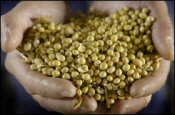



Study: an Answer to the Food Vs Fuel Debate?
US – There has been intense public debate during the last year about the impact of the growing U.S. ethanol industry on consumer food prices. That debate has been fueled mainly by anecdotal information and speculation. Today, Informa Economics is releasing a detailed statistical analysis that brings focus to the issue. |
| The report seeks for the root cause of food price inflation |
The Informa report identifies the so-called “marketing bill”—the portion of final food costs that excludes grains or other raw materials—as a key driver of the consumer price index (CPI) for food, largely due to rising energy and transportation costs. Another significant factor in consumers’ food bills is surging global demand for commodities.
The report finds a comparatively “weak correlation” between corn prices and overall food costs. In fact, just four percent of the change in the food CPI could be attributed to fluctuations in the price of corn. Simply put, growing U.S. ethanol industry is not the cause of food price inflation.
“This analysis puts to bed the argument that a growing domestic ethanol industry is solely responsible for rising consumer food prices,” said Informa Chairman and Chief Executive Officer Bruce Scherr. “The statistical analysis plainly details that energy-intensive activities such as processing, packaging and transporting, as well as the cost of labor, have a far greater impact on consumer food bills than the price of grain. It may be politically convenient to blame ethanol for rising food prices but it doesn’t make it factually accurate. As far as Informa is concerned, this debate is settled.”
The debate around the root cause of rising food prices has taken on an increasingly emotional, rather than factual, character. To center the debate back on the solid footing of statistical analysis, Informa has outlined a number of key findings from its report, including:
- The “farm value” of commodity raw materials used in foods accounts for 19% of total U.S. food costs, a proportion that has declined significantly from 37% in 1973. The remaining portion of total retail food costs is known as the marketing bill, which includes the costs of labor, packaging, transportation, energy, profits, advertising, depreciation, rent, interest, repairs, business taxes and other costs not attributable to basic agricultural commodities.
- The marketing bill has a higher correlation with the consumer price index (CPI) for food than does corn, although there is a notable long-term upward trend to both the marketing bill and the food CPI.
- There is no statistical evidence to suggest that high and/or rising corn prices are the causative reason behind high and rising retail meat, egg and milk product prices.
- The proportion of the average American’s disposable income spent on food has declined steadily over the last half-century, from 21% of disposable income in 1950 to below 10% in 2006.
- No single factor drives consumer food prices over time. That has also been true of the moderately higher-than-average inflation during the first three quarters of 2007. There is actually a complex and interrelated set of factors that contribute to food prices.
* "the statistical evidence does not support a conclusion that there is a strict ‘food-versus-fuel’ tradeoff that is automatically driving consumer food prices higher." |
|
Report: Analysis of Potential Causes of Consumer Food Price Inflation
|
“Informa lays bare the facts as to why Americans are paying more for everything from milk to Captain Crunch,” said Bill Lee, chairman of the Renewable Fuels Foundation, which commissioned the analysis. “Much to the chagrin of those in the livestock, meat and food processing, and oil industries, it isn’t the growth of the U.S. ethanol industry. Soaring energy prices, increasing global demand and rising labor costs have a far more significant impact on food prices than stronger corn prices due in part to ethanol demand. Given the reputation of Informa among those in the agricultural and livestock industries, this report should bring an end to the disingenuous debate about food versus fuel.”
The analysis concludes:
“While there have been a number of stories in the media over the last year indicating that consumer food prices are being driven higher by an ethanol-induced increase in corn prices, there is little evidence of such a simplistic cause-and-effect linkage. … While an increase in corn prices will affect certain industries – for example, causing livestock and poultry feeding margins to be lower than they otherwise would have been – the statistical evidence does not support a conclusion that there is a strict ‘food-versus-fuel’ tradeoff that is automatically driving consumer food prices higher.”
Further Reading
|
|
- View the 'Analysis of Potential Causes of Consumer Food Price Inflation' . |
|
|
- Go to our previous news item on this story by clicking here. |








